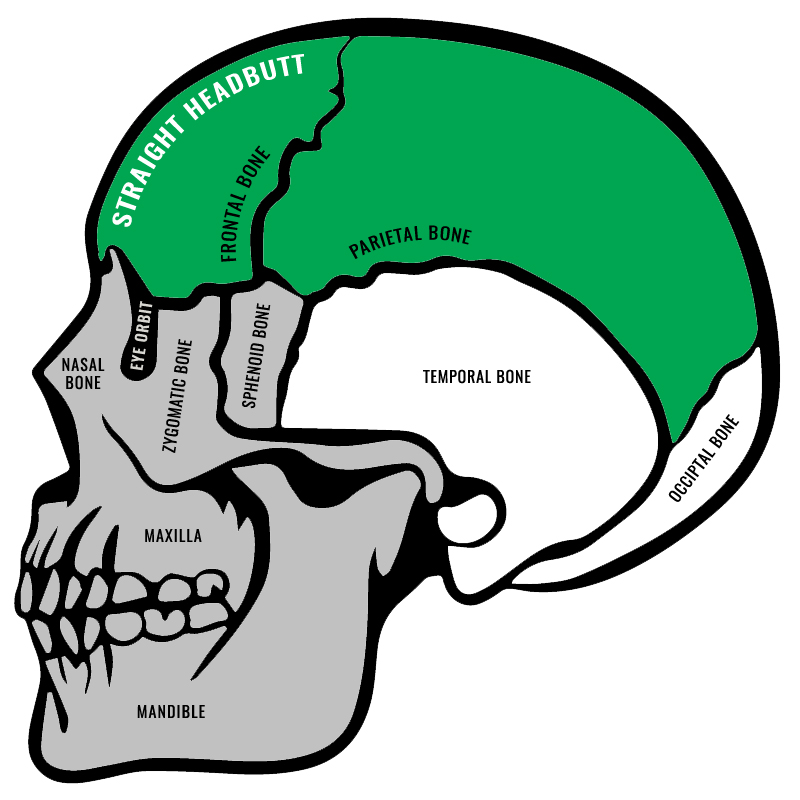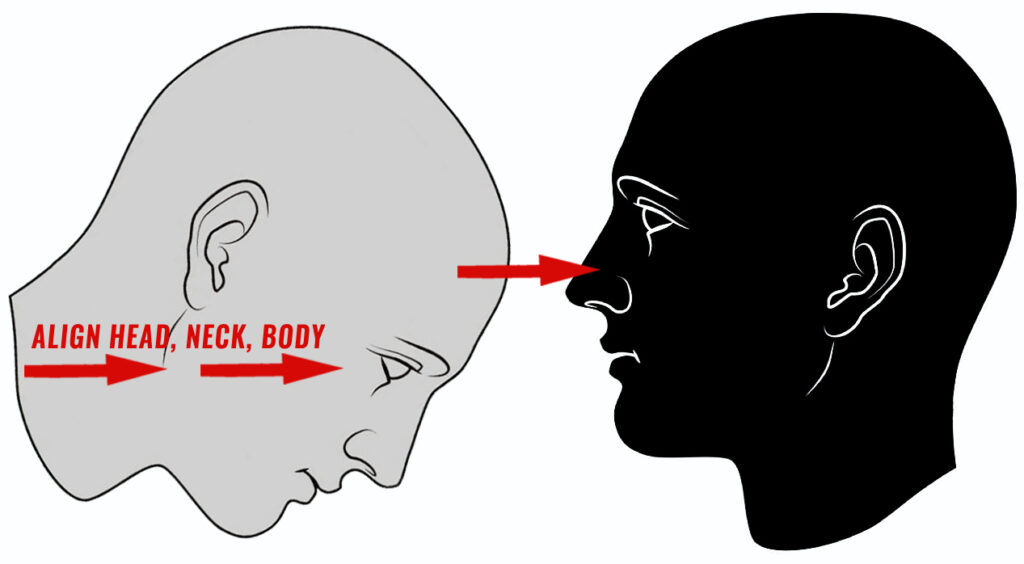
Academy Menu
Module Menu
Module 1 Lessons
Techniques
Tactics
Culture
Knowledge
Technique
Straight Headbutt
Learning Objectives
At the completion of this lesson, including review and applicable practice, the instructor candidate will be able to:
- Indicate the anatomical location that used the straight headbutt.
- Identify the ranges of straight headbutt use.
- Describe the three biomechanical attributes of the straight headbutt.
- Analyze tactical considerations when using the straight headbutt.
- Demonstrate the straight headbutt in the air and on focus mitts.
- Demonstrate three combinations that emphasize the straight headbutt in the air and on focus mitts.
Overview
Before proceeding with this lesson, please review the Open Access lesson, “The Headbutt in Lethwei: An Introduction” by clicking HERE.
The straight headbutt, as its name suggests, is a forward strike using the crown or the top of the forehead, aiming for an opponent’s face, particularly the nose, jaw, or forehead. Executing a proper headbutt requires precision and awareness of distance. The fighter must maintain a solid stance, close the gap quickly, and strike with the hard bony part of the skull to maximize damage while minimizing self-harm.
To execute a straight headbutt effectively, the fighter often uses their legs to generate forward momentum, shifting body weight into the strike. The neck plays a crucial role in guiding the head into position, while the shoulders remain relaxed but ready to brace for impact. Ideally, the strike lands with the upper forehead, which is a strong and solid area, rather than the face or the nose, which are more vulnerable to injury. Timing is critical—headbutts are most effective when thrown during close-range exchanges, especially in the clinch, or in moments of disrupted rhythm when an opponent is unprepared for such an unorthodox attack.
In Lethwei, headbutts can be used both offensively and defensively. On offense, the straight headbutt is often combined with punches, elbows, or in the clinch. When an opponent’s guard is up and their face is exposed or when they are caught off balance, the headbutt can be thrown to quickly damage or disorient them. The clinch is perhaps where the straight headbutt shines the most; in close-quarters fighting, where punches and kicks are less effective due to lack of space, headbutts become a powerful tool. Fighters control their opponents’ posture and positioning, using their heads as battering rams to overwhelm and destabilize them.
Defensively, a headbutt can also be used as a counterstrike. When an opponent closes the distance aggressively, instead of retreating or blocking, a fighter might throw a quick straight headbutt to interrupt the attack, often catching the opponent off-guard. The speed and surprise factor of the headbutt, combined with the inherent toughness of the skull, makes it a difficult strike to defend against.
Key Concepts
- The straight headbutt can be used at intermediate, close, and clinching ranges.
- The striking surface for the straight headbutt is the frontal bone of the skull.
- For the straight headbutt, the head/neck should remain in line without bending the neck.
- The straight headbutt should be executed in a forward thrusting motion.
- The mouth should be closed and the jaw muscles taut during impact.
- Power comes from the legs and not a snapping motion from the neck.
Instructional Media
When executing the straight headbutt, the contact surface of the head/skull is the frontal bone. All headbutts should be well-trained and used with precision and caution.

It is essential for effectiveness and safety that the straight headbutt be executed in a forward thrusting motion with the head, neck, and body aligned. There should be minimal flexion (bending) of the neck during execution. The driving force for the straight headbutt comes from the legs.

Developmental Practice
Practice the new technique frequently and systematically. All techniques should be practiced from both orthodox and southpaw leads. Begin by practicing the technique slowly without contact. From there, progress to solid targets such as focus mitts. Add the technique to your regular training sessions and explore it use within your current fighting art toolbox. Once you are executing the technique proficiently, proceed to the next level of technical development.
Make a video recording of your technique execution in the air and then against focus mitts or another type of pad. Review the video of your technique execution. Evaluate your execution of the techique in terms of mechanics and efficiency. Make any necessary corrections in your practice of the technique. Be sure to use caution when practicing techniques against focus mitts, heavy bag or pads of any type, be sure to execute at a reduced speed and force. Gradually increase intensity to minimize the risk of injury.
Functional Combinations
Practice the new combinations frequently and systematically. All combinations should be practiced from both orthodox and southpaw leads. Start the combination learning process slowly without contact and progress to focus mitts and/or other targets. Add them to your regular training sessions and explore including those that work for you in your toolbox.
- jab – straight headbutt
- jab – cross – straight headbutt
- parry opponent’s jab – slip inside opponent’s cross – straight headbutt
- parry opponent’s jab – slip outside opponent’s cross – bob & weave inside opponent’s hook – straight headbutt
It is suggested that you video the combinations similar to the process used in your technique video analysis. Using the video recording of the combinations, evaluate your execution of them in terms of mechanics, fluidity, and efficiency. Make any necessary corrections in your practice of the combinations. Be sure to use caution when practicing combinations against focus mitts, heavy bags or pads of any type. Execute them at a reduced speed and force and gradually increase intensity to minimize the risk of injury.
Review
- Indicate the anatomical location that is the striking surface for the straight headbutt.
- What are the ranges that may be used when executing the straight headbutt?
- What are the three biomechanical attributes of the straight headbutt?
- What are the tactical considerations for straight headbutt execution?
- Perform the straight headbutt in the air
- Perform the straight headbutt against a focus mitt.
- Perform three combinations in air that emphasize the straight headbutt.
- Perform the three combinations that emphasize the straight headbutt against focus mitts.
Instructor Level 1 Assessment and Review
Knowledge of and proficiency with this technique is a required component for the Thut Ti Lethwei Global Instructor Level 1 (Saya Dit) Pathway. During the official Instructor Level 1 assessment and review, Instructor Candidates may be asked to describe this technique verbally and/or in written format. Instructor Candidates may also be asked to demonstrate this technique in isolation and/or in an applied context.
Thut Ti Lethwei Global Academy Disclaimer
The information provided on Thut Ti Lethwei Global Academy (lethwei.net) is intended for general informational and educational purposes only. The content on this Website is not intended as a substitute for instruction or direction from a professional combat sports coach or martial arts instructor. The content is also not intended as a substitute for medical direction, advice, diagnosis, or treatment from a health care professional. Always seek the advice of your physician or other qualified health provider with any questions you may have regarding a medical condition or th e safety of participating in any physical activity.
Not Medical Advice: The content on this Website is not intended to be a substitute for professional medical advice, diagnosis, or treatment. Always seek the advice of your physician or other qualified health provider with any questions you may have regarding a medical condition.
Consult a Professional: It is essential to consult with a healthcare professional before starting any new activity program, diet, or exercise routine. Your individual training goals should be discussed with a qualified healthcare provider who can provide personalized recommendations.
Assumption of Risk: Participation in physical activity and exercise carries inherent risks, and by using the information provided on this Website, you acknowledge and voluntarily assume these risks. Always exercise caution and common sense when engaging in physical activities.
Accuracy of Information: While we strive to provide accurate and up-to-date information, the content on this Website may not always reflect the most current research or medical guidelines. We do not guarantee the accuracy, completeness, or timeliness of the information presented.
Responsibility: You are responsible for your health and safety when engaging in any combat sport, martial art, or fitness program, individual exercise, or dietary practice discussed on this Website. Thut Ti Lethwei Global Academy, its authors, contributors, and affiliates disclaim any liability for any injury, loss, or damage incurred as a result of the use or reliance on the information provided on this Website.
Changes to Disclaimer: Thut Ti Lethwei Global Academy reserves the right to modify or update this disclaimer at any time without prior notice. It is your responsibility to review this disclaimer periodically for any changes.
By using Thut Ti Lethwei Global Academy website, you agree to the terms of this disclaimer. If you do not agree with these terms, please refrain from using this website.
